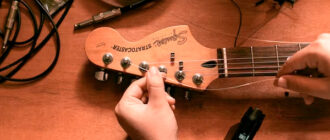
How does a guitar tuner work: Hey there, guitar enthusiasts! Have you ever wondered how your trusty guitar tuner actually works, especially when it comes to tuning lower or higher strings? Well, you’re in the right place! In this blog post, we’ll dive into the fascinating world of guitar tuners, exploring their magic and comparing their accuracy. Grab your favorite six-string companion, and let’s learn about the crucial instrument settings and the fundamental tone extraction process when the note is in tune.
Have you ever wondered how your guitar tuner works? Before we delve into the inner workings of guitar tuners, let’s quickly define what they are. A guitar tuner is a nifty little device that helps you ensure each string on your guitar is playing at the correct pitch. It takes the guesswork out of tuning and ensures your instrument sounds its best. Such tuners are used on many string instruments like a violin, when you want to tune it to play a chord right. Now, let’s explore the two most common types of guitar tuners.
Table of Contents
What Is a Guitar Tuner?

Image by Facundo N. Aranda Fabre from Unplash
Non-chromatic and chromatic tuning are not that different from each other.
1. Chromatic Tuners:
Chromatic tuners are the go-to choice for most guitarists. These versatile tuners can detect and tune any note on the chromatic scale, and the chromatic tuning seems to be the most accurate. Whether you’re in standard tuning (E-A-D-G-B-E) or experimenting with alternate tunings, a chromatic tuner has got your back. It displays the name of the note being played and shows you whether it’s sharp or flat because it detects a signal while secured onto the headstock.
There is also sometimes a value in the form of a number which shows the additional frequencies produced like B9 or A7. The fundamental is extracted using a mechanism based on an algorithm. To the instrument its timbre is very important, and to accurately detect pitch
2. Non-Chromatic Tuners:
Non-chromatic tuners, on the other hand, are specifically designed for beginners or players who stick to standard tuning. They are simpler to use and typically only detect the six notes of standard tuning and show the nearest relative note when the pitch is detected. A non-chromatic tuner is a great option if you’re just starting out on your guitar journey.
How Does a Guitar Tuner Work?
Now that we have a basic understanding of what guitar tuners are and how they are used in standard ways, let’s dive into how they work their magic. Guitar tuning is all about getting each string to vibrate at the correct pitch when plucked or strummed. Tuners help us achieve this by detecting the pitch of the note and guiding us to make adjustments, Microphone tuners are easier to use, especially on a bass guitar.
How Does a Tuner Work?

Image by lilartsy from Unplash
1. Clip-On Tuners:
Clip-on tuners are incredibly popular these days, and for good reason. They attach to the headstock of your guitar and use a built-in sensor to detect vibrations from the strings. When you play a string, the tuner analyzes these vibrations and determines the pitch of the note. It then displays this information on a digital display or a physical needle, showing you how close you are to the desired pitch. If you like a clip-on tuner, it’s great, because this tuner offers an analysis of sound vibrations. Clip-on tuners work for a long time without malfunctioning and helping with your guitar’s tuning. They are sometimes called the piezo tuners.
2. Microphone Tuners:
Some tuners rely on a built-in microphone to pick up the sound of your guitar. These tuners work in much the same way as clip-on tuners, but instead of detecting vibrations, they capture the sound waves produced when you play a string. The tuners process this audio signal and provide you with the pitch information you need.
3. Smartphone Apps:
Thanks to technology, you can now use your smartphone as a tuner too! There are numerous tuner apps available for both Android and iOS devices. These apps utilize your smartphone’s microphone to pick up the sound of your guitar and analyze the pitch. They offer a graphical representation of a needle or a digital display to show you how in tune your guitar is. It is the most convenient for acoustic instruments.
Some people also use a pedal tuner or a preamp (though it depends on the battery life, voltage and power, so initial weak signal would be harder to decipher than analog sound waves), a strobe tuner, so there is a choice among many tuners, those who catch vibration or sound, those for a beginner or a pro, no matter acoustic-electric or any other guitar. But if you want to tune your guitar with a tuning fork, you’ll need some skill.
How Do You Tune a Guitar with a Tuner?
Using a tuner to tune your guitar is a breeze. Here’s a step-by-step guide to get you started:
1. Attach a clip-on tuner to the headstock of your guitar or launch a tuner app on your smartphone.
2. Play each string individually, starting from the lowest string (E) and moving up to the highest (E). Strumming a chord won’t work.
3. The tuner will detect the pitch and show you whether the string is in tune or requires adjustment.
4. If a string is out of tune, tighten or loosen the corresponding tuning peg until the tuner shows that it’s in tune.
5. Repeat the process for all the strings until your guitar is perfectly tuned.
What’s the Difference Between Electric Guitar Tuners and Acoustic Guitar Tuners?
The main difference between electric guitar tuners and acoustic guitar tuners lies in their method of detecting the pitch. Electric guitar tuners often have built-in pickups or preamps that directly detect the vibrations of the strings. Acoustic guitar tuners, on the other hand, rely on clip-on or microphone detection methods.
Tips:
– When tuning your guitar, it’s important to tune each string relative to the others. Start with the lowest string and work your way up.
– In a noisy environment, using a clip-on tuner or a tuner app on your smartphone can be handy as they can pick up the vibrations or sound directly from your guitar, minimizing external noise interference.
Warnings:
– Avoid overtightening your strings while tuning, as it can lead to breakage. Tune with gentle adjustments and listen carefully to the changes in pitch.
– Make sure to regularly check and replace the batteries in your tuner to ensure accurate readings and optimal performance.
Guitar tuners have come a long way, from simple pitch pipes to sophisticated digital devices and smartphone apps. They accurately detect the pitch of each string and guide us towards achieving the perfect tune. So, the next time you wonder how your guitar tuner works, remember that it’s not that difficult and can also be used to tune the guitar to an unusual tuning.






